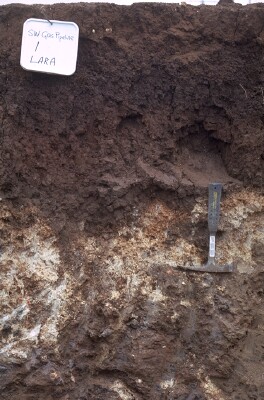SW103
Location: Lara
Australian Soil Classification: Epicalcareous - Epihypersodic, Massive, Red VERTOSOL (moderate profile depth)
General Landscape Description: Near level plain.
Site Description: Broad flat ridge with easterly aspect slope <1%.
Geology: Quaternary Basalt.
Soil Profile Morphology:
Surface Soil
| Ap | 0-12 cm | Brown (7.5YR4/3 moist); hardsetting surface condition; light clay; apedal structure; contains shelly material including intact shells; pH 7.9; clear and smooth change to: |  SW103 Profile - Note: Surface stripped from soil profile. |
| Subsoil | |||
| B21t | 12-30 cm | Dark reddish brown (5YR3/3 moist); medium heavy clay; fine prismatic structure, parting to fine polyhedral; pH 9; clear and smooth change to: | |
| B22ss | 30-60/75 cm | Dusky red (2.5YR3/3), becoming brown (7.5YR4/3) at depth; medium heavy clay; prominent slickensides (up to 30 cm across); pH 9.5; clear and wavy change to: | |
| B23k | 60/75-80/100 cm | Reddish yellow (7.5YR6/8) becoming reddish yellow (7.5YR7/8) at depth; abundant soft calcium carbonate (CaCO3); irregular change to: | |
| C | 80/100+ cm | Weathering vesicular soft greenish basalt; tongues of calcium carbonate (CaCO3) from B23k above; some biological activity present (ant nests). |
Key Profile Features:
- High (>35%) clay content throughout the soil profile.
- Massive (hardsetting) surface horizon.
- Vertic features (slickensides) in subsoil.
- Calcium carbonate segregations in deeper subsoil.
- Moderate soil profle depth – overlying weathering fractured basalt.
Soil Profile Characteristics:
pH | Salinity Rating | |||
Surface (A1 horizon) | Slightly Alkaline | Low | Non-Sodic | None1 |
Subsoil (B21 horizon) | Strongly Alakaline | Low | Strongly Sodic | Moderate-Strong |
Deeper Subsoil (at 40-55 cm) | Very Strongly Alkaline | Medium-High | Strongly Sodic | Strong-Complete |
| 1 Strong dispersion after remoulding. | ||||

| The surface is slightly alkaline. The subsoil is strongly alkaline becoming very strongly alkaline at depth. | Salinity rating is low in the surface and upper subsoil becoming medium to high at depth. | The soil is non sodic in the surface and strongly sodic in the subsoil. | The clay content is high throughout the profile. |
Horizon | Sample Depth (cm) | pH (water) | pH (CaCl2) | EC 1:5 | NaCl % | Exchangeable Cations | |||
Ca | Mg | K | Na | ||||||
meq/100g | |||||||||
A1 | 0-10 | 7.9 | 7.3 | 0.2 | 21 | 4.1 | 1.5 | 0.8 | |
B21 | 15-30 | 9 | 8 | 0.42 | 0.02 | 15 | 8.8 | 1.4 | 7 |
B22 | 40-55 | 9.5 | 8.8 | 0.73 | 0.04 | 7.7 | 16 | 1.9 | 12 |
Horizon | Sample Depth (cm) | Organic Carbon % | Nitrogen % | Field Capacity pF2.5 | Wilting Point pF4.2 | Coarse Sand (0.2- 2.0 mm) | Fine Sand (0.02- 0.2 mm) | Silt (0.002- 0.02 mm) | Clay (<0.002 mm) |
A1 | 0-10 | 2.3 | 0.26 | 33.1 | 18.4 | 12 | 21 | 17 | 42 |
B21 | 15-30 | 55.3 | 29.6 | 5 | 14 | 11 | 65 | ||
B22 | 40-55 | 63.7 | 35.3 | 4 | 14 | 17 | 58 |
Management Considerations:
Whole Profile
- The relatively high wilting point (i.e. 18%) indicates that plants will be unable to fully utilise light rains when the soil is dry.
- Tillage of cracking clay soils should be avoided if the soil is wet (i.e. wetter than the plastic limit). At such moisture conditions, excessive tillage, trafficking or over stocking could result in structural damage (i.e. compaction, smearing) occurring. Ideally tillage and trafficking should take place when the soil is drier than the plastic limit.
Profile Described By: Richard McEwan (February 1999).


